There was a time (a few days ago) when I was blissfully unaware of the existence of Moray Park. It was a neighbourhood that appeared and then disappeared, and is now long forgotten like some Glaswegian Brigadoon. Even those few who knew of it weren’t sure where it was.
So it’s time to reveal the story of Moray Park.
When modern Strathbungo was first developed in the 1860s-1880s it was given the fancy name of Regents Park. This persisted into the early 20th century, but finally lost out to Strathbungo, and is largely forgotten. Like the street names, it refers to the Regent Moray (Regent Park Square, Moray Place), who fought Mary Queen of Scots (Queen Square) at the nearby battle of Langside.
Building stalled following completion of Princes (now Marywood) Square in 1884, leaving a large plot of vacant ground to the south between Marywood Square and Titwood Road. I had assumed it remained farmland or waste ground, but this was Moray Park, and it had a rather more interesting history, particularly for sports fans.
Romans
The first mention of Moray Park is in an account of finding possible Roman coins, although the story is told in retrospect .
Mr Gavine also told me that very many years ago, probably about 1875, Roman (?) coins were found on a small hillock which stood at what is now the junction of Moray Place and Vennard Gardens, Strathbungo. Mr Gavine put me in touch with his informant, Mr William Taylor, who was over eighty years of age in 1945, and who as a boy of ten or twelve had often seen coins picked up by the potato-diggers in the field then called Moray Park. The coins “were all of copper about the size of a penny but a little thicker,” and Mr Taylor believed them to be Roman. If so, they were probably imperial bronze coins of the first, second, or early third century A.D.
The Victorian terrace at the corner of Moray Place and Vennard Gardens was completed around 1872, but stood out quite alone for the next 50 years, with open ground behind and to the side of it.
Early sport
The second half of the 19th century saw a boom in recreational sporting activity for men (though sadly, rarely women). This led to the formation of many sports clubs, and the codifying of sports such as football and rugby.
Rounders and other sports
The first reference to Moray Park in the British Newspaper Archives is in March 1885, when Langside Rounders were using it as their home ground, having been formed some three years earlier. In May that year they defeated The Citizen by 287 runs to 32 with an innings to spare. Ouch .
In 1886 the Paisley Daily Express reported a break-in at the Moray Park clubhouse, in which tennis racquets and cricket bats were stolen, but these were recovered when the culprits were apprehended .
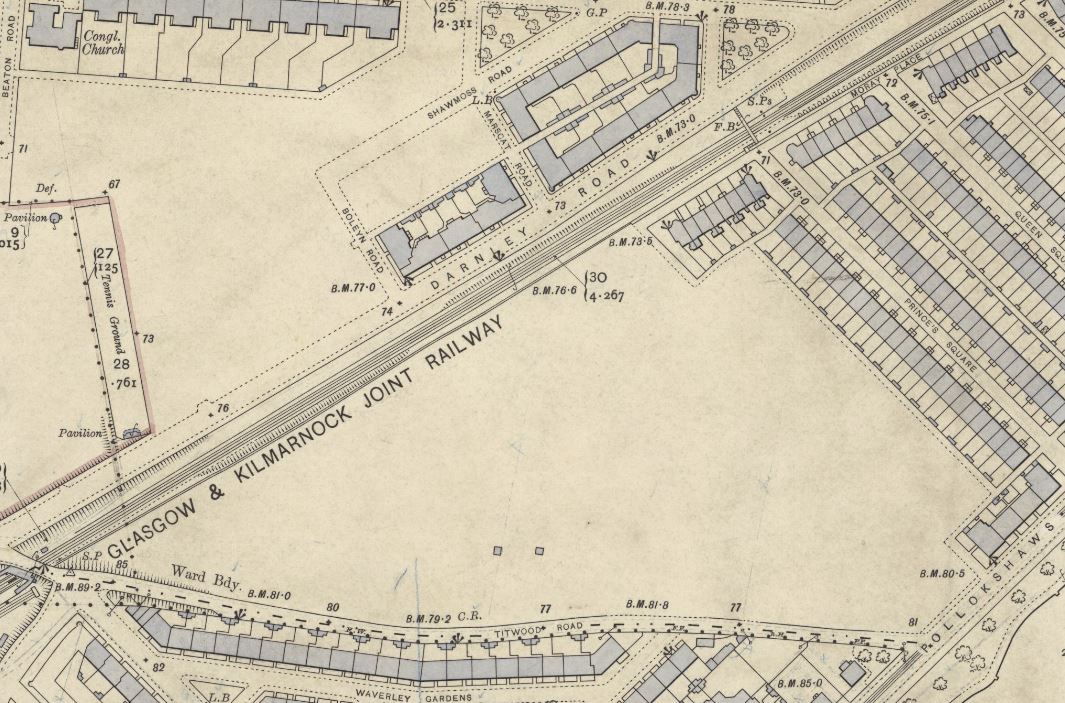
1910 OS Map shows two small buildings on the Moray Park site, possibly small clubhouses. Source: NLS Maps
Football
The first recorded football match was in October 1885 between St Andrews, who took Moray Park as their home ground, and (Glasgow) Cambridge. The papers also reported a home game at Moray Park for another club later the same month; Southern Athletic, who played Clune Park Swifts.
Curiously, Cambridge had hosted Southern Athletic in the Scottish Cup the previous month. Southern lost, but complained about unregistered players and were granted a replay. They lost that too, 2-1. Cambridge’s reward was a second round tie against St Andrews at Moray Park, the game described above. St Andrews won 6-0 .
St Andrews and Southern Athletic played each other at Moray Park in January 1887, but St Andrews later moved grounds. Southern Athletic persisted until folding around 1893. However in nine Scottish Cup entries, they only ever won one tie.
Other football teams that played at Moray Park included Glenure Athletic and Glencairn in the mid 1890s, while Wellcroft used the ground in 1914. A member of Glenure Athletic, George Morrell, went on to manage Greenock Morton, The Arsenal, and Third Lanark. He remains infamous as the only manager to ever relegate Arsenal, but also oversaw their move from Woolwich to Highbury .
There is also a story that when Rangers FC were required to move from Kinning Park c 1887, they identified Moray Park as their new ground, but that the Strathbungo locals objected to the presence of such ruffians in their midst, and Rangers moved to Ibrox instead.
Cartha Queens Park RFC
Southern Athletic’s club secretary, James Kirkland, left to become secretary at newly formed Cartha Athletic in 1889. The club began with cricket on Moray Park. The club’s history noted this first ground was “just off Pollokshaws Road” but was unable to determine where exactly that was, assuming it was in Queens Park .
The club struggled initially to gain members, but in 1890 rather unusually admitted women members, and took up cricket, tennis and football at the old Pollokshields Athletic Club ground in Pollok Park, roughly opposite St Andrews Drive. However in 1891 they moved again, a short distance along the park to Dumbreck, when the new drive and Lodge was constructed from St Andrews Drive to Pollok House. They took their new clubhouse with them. They briefly developed a large cycling contingent, and became well known for their hockey teams.
Around 1906 they took up rugby, and eventually became Cartha RFC. In 1974 they merged with Queens Park F.P. (F.P., former pupils of Queens Park Secondary School), and Cartha Queens Park RFC still play at Dumbreck today.

Goerge Morrell, Dentist and Football Manager. Source: A Beattie, FindAGrave
Shinty
But it is shinty for which Moray Park was best known, as evidenced by an exchange in the Daily Standard, a Brisbane newspaper, on the occasion of a visit to Australia by some hockey teams . The mayor confessed to ignorance of the game – “something I used to play with a stick and a jam tin” – and was informed that
…hockey was now a highly scientific game, with elaborate equipment in no wise resembling the broomsticks and jam tins of the old shinty days.
This produced a striking response from a reader.
SANDY M‘WHACHLE protests, — The gowk wha wrote yon “ Mirror” par “Shinty and Hockey” (20/8/27) should gang and get his heid read. Imagine ony sensible body sayin’ that hockey, unlike shinty, is a scienteefic game. Compared wi’ shinty, hockey is a game for wee lassies. Mony a time ha’e I played shinty with the lads o’ Cowal an’ Skye on the famous Strathbungo ground in Glesca, an’ let me tell ye, nane o’ yer hockey players could stand the race. It takes a great deal o’ skill, and a true eye tae drive a ba’ wi’ a shinty club, and Sassenachs canna play the game because they didna get the richt kin’ o’ milk when they were young.
I presume the editors made this up – Sandy McWhachle appears to be a traditional butt of Scottish jokes – but nonetheless some sub-editor in Brisbane must have known Strathbungo was famous!
Glasgow Cowal Shinty Club was formed in 1877 to provide exiled Highlanders somewhere to play their beloved sport. In 1878 they won the inaugural Glasgow Celtic Society Cup, the oldest competition in shinty. They were to win it on three further occasions, 1905, 1907 and 1909. They started playing at Glasgow Green, and then in Woodville Park (at or next to Ibrox Stadium). Their first recorded appearance at Moray Park was in 1892.
Shinty. — The ancient Celtic pastime is played by the Glasgow Cowal Shinty Club. The club was formed in March, 1877, and was confined to natives of the district of Cowal Argyllshire, resident in the city ; but after some years of exclusiveness the membership was thrown open to anyone, and the result was a large increase in numbers. Their first ground was on Glasgow Green, then Cessnock Park, and now they are located at Moray Park, Strathbungo .
In April 1893, Glasgow Cowal travelled to Ruthven to defeat Kingussie, a match which became famous as it was a major influence on those wishing to codify the game, and so led to the formation of the Camanachd Association.

Glasgow Cowal pose after victory against Kingussie in 1893. Source: Glaschu.net
Cowal contested the first ever Camanachd Cup Final in 1896, but this time Kingussie prevailed.
There is a time honoured tradition of the New Years Day shinty game, and in advance of the January 1897 game between Glasgow Cowal and Oban, John MacKay, Cowal supporter and editor of Celtic Monthly magazine, wrote a glowing account of the joys of the New Years game, and invited his readers to come and watch . Unfortunately Oban wired to Glasgow that they were unable to travel and the game was called off!
However MacKay’s article had a bonus, the first ever photographs of a shinty game, taken at an earlier match at Moray Park between Glasgow Cowal Reserves and Edinburgh Sutherland. This may have been the match on 18 May 1895, when a photographer was present, and Cowal won 5-1 .
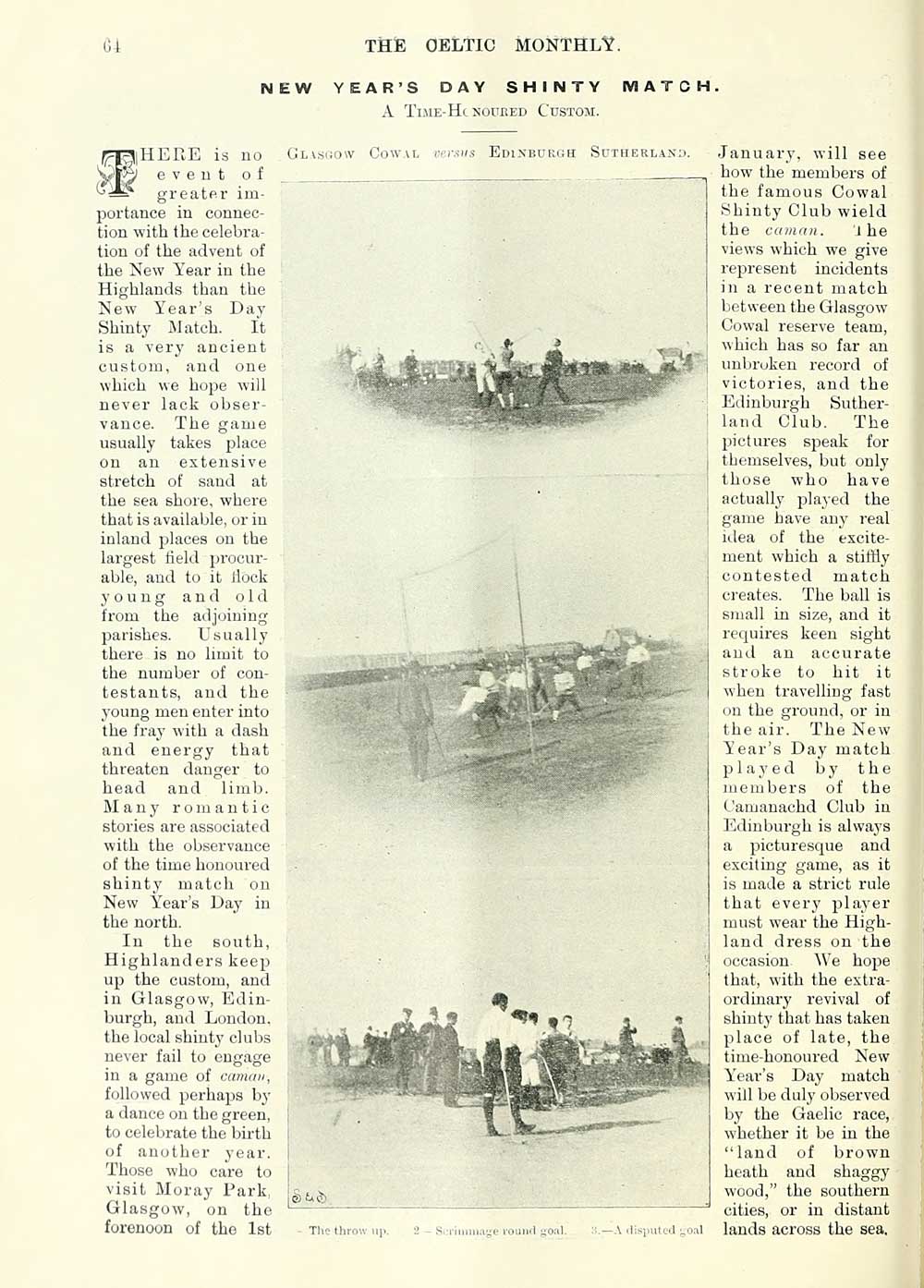
The Celtic Monthly, January 1897. Source: National Library of Scotland
What is striking about the photographs is that they confirm the location of Moray Park. They are all taken from the same spot, and in the background one can see a seemingly solitary house that strongly resembles 33 Moray Place. There is no other similar house in the area.

Shinty match in progress, with 33 Moray Place ringed.
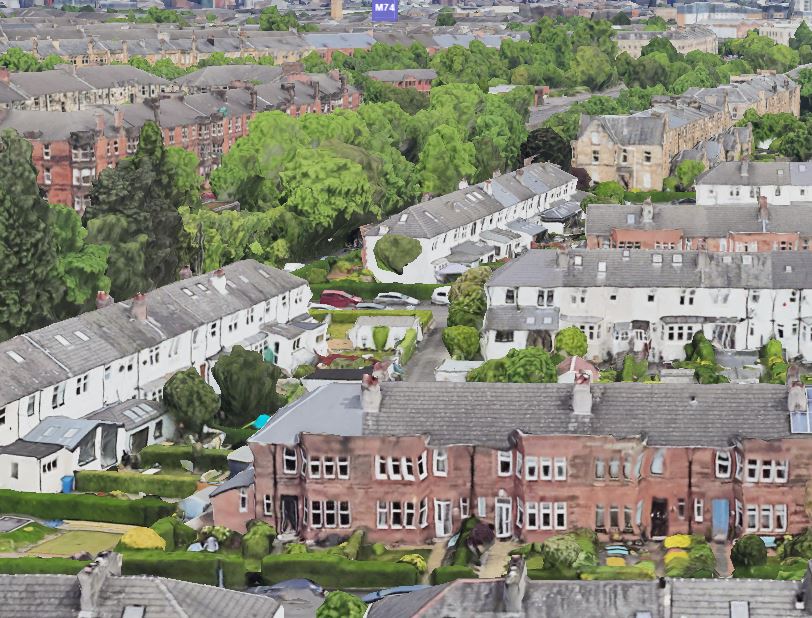
Roughly the same view in Google Earth, suggesting the match took place around Carswell Gardens.
Glasgow Cowal are said to have folded in the 1920s or 1930s, but they disappeared from the newspapers in 1913. Glasgow Oban and Lorne took over at Moray Park, but the Great War must have brought shinty to a halt – any Highlander fit enough to play would likely be fit enough to fight too. Several former Cowal players were reported to have died in the fighting.
Tragedy
Two police officers patrolling at Moray Park one morning in 1909 noticed a man leaning on the fence, wearing a hat and with his hands in his pockets. On closer inspection however, they found him quite dead, and hanging from the fence by a leather strap. They found a note in his pocket, his own obituary notice .
“BRADY” – Suddenly, at Glasgow, “Joseph Brady” (of London) commission agent. No flowers, by request. Funeral private.
Once all right, but by misbehaviour come to this. No friends in Glasgow, thank God, and do what you like with my remains, as they will not be claimed. Sorry at whatever bother I may cause, also at the expense I am causing the State, but then you must not forget that I am saving the State my old-age pension. So there you are, and here I am – away, so there is no chance of argument. Good-bye!”
Poor Joseph had lived at 115 Minard Road, but had been out of work for two years.
Allotments
Sporting endeavour appeared suspended by the war, and there was great demand for allotments to grow food, so in 1918 the 10 acres of Moray Park was given over to providing 200 plots . However in 1921 the Moray Park Allotment Association was served notice that half the plots had to be vacated for the formation of new roads . This would be the re-alignment of Titwood Road.
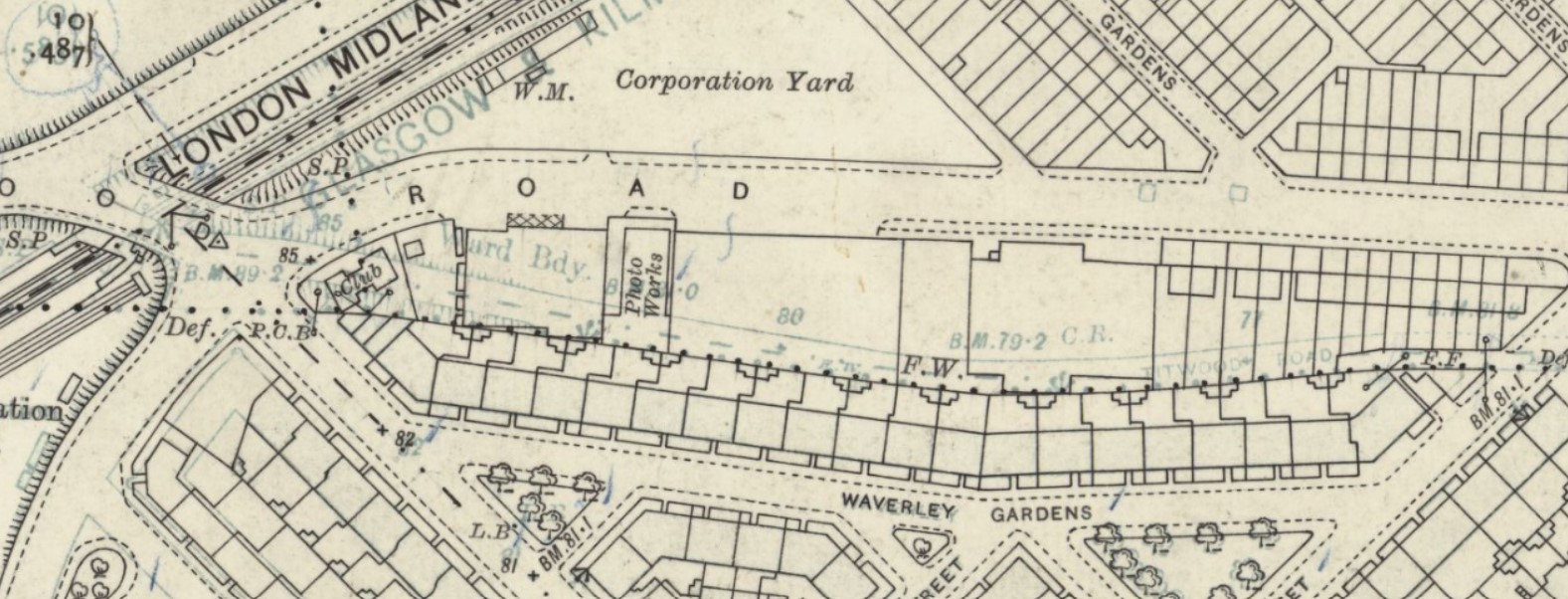
1935 OS Map in preparation, overlaid over 1910 map. Two different alignments for Titwood Road are shown, with a reduction in the size of Moray Park. The old “clubhouses” are now in the middle of the road. Source: NLS Maps
Moray Park Covered Tennis Courts
The road realignment created some new space on the other side of Titwood Road, which was taken up by a combination of housing and commercial properties. One of these was the impressive Moray Park Covered Tennis Courts at 75 Titwood Road.
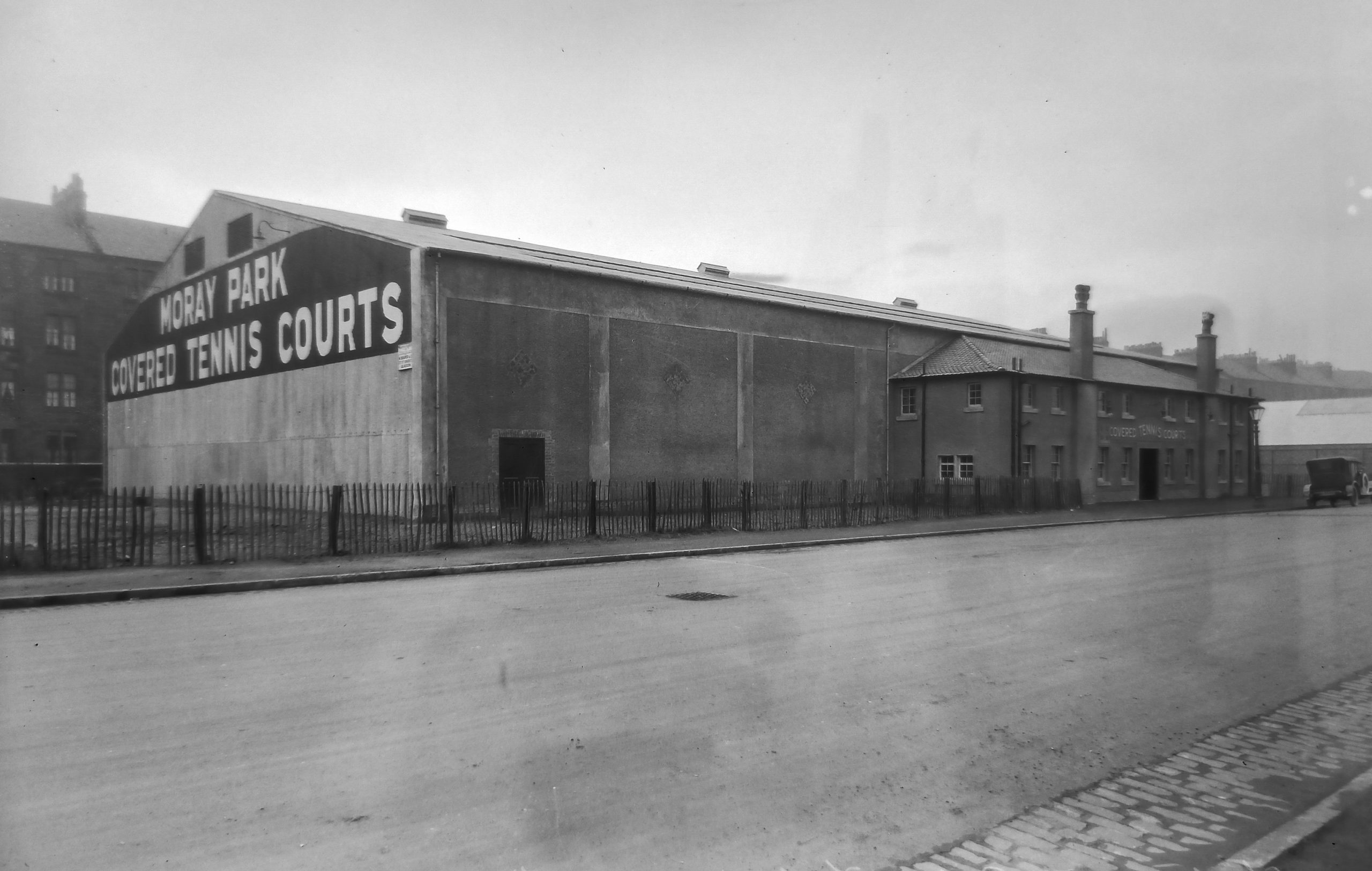
Moray Park Covered Tennis Courts on Titwood Road, February 1925. Source: Glasgow City Archives D-CA8/3240
Had you played there you would have had the opportunity to be coached by a former Scottish Champion, Mrs Robin Welsh. Although from Edinburgh, she chose Strathbungo because covered courts were so rare at that time. She had turned professional in order to take up coaching as she came to the end of her playing career. Her real name was Mary (Molly) Welsh, nee Gray, and she won the Scottish Championships six times, 1905, 1913-14 and 1921-23.

Tennis coaches. Sunday Post, 20 Feb 1927. Source: BNA
The courts struggled financially, and in 1926 the site was bought by well known Glasgow showman AE Pickard. Speculation suggested it might become a motor garage, a dancehall, a picture house or a skating rink . However the courts were still in use in March 1927 when Glasgow’s first indoor tennis tournament was staged and reported extensively in the papers. Notably on the first day, Mr JS Richardson, 67, died on court during a singles match. However after that tournament there is no further mention of the courts in the press.
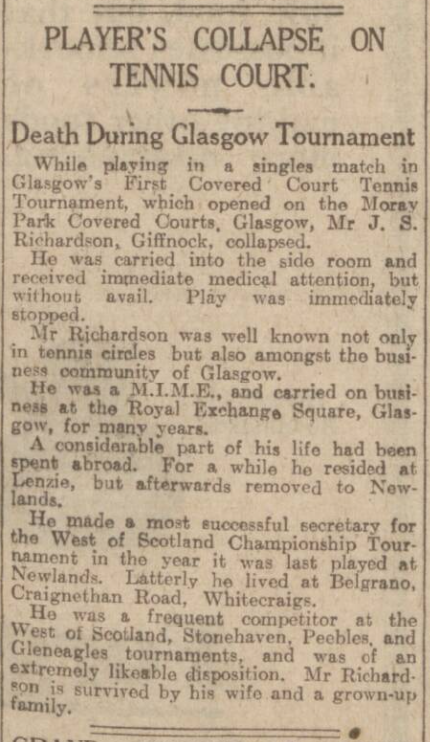
Death on court at Moray Park Covered Tennis Courts. Dundee Evening Telegraph, 8 Mar 1927. Source: BNA.
The closure of the courts was announced in the Herald in December 1927 after only three years, due to a lack of public support. In 1929 Pickard submitted plans for minor alterations, with a lean-to around the building perimter, but these were abandoned.
In February 1932 the Glasgow magistrates permitted the building to be used for a one-off night of boxing matches. This did not go down well with the locals in Strathbungo’s new Gardens houses, as conveyed by “Not Again” in a letter to the Herald.

Letter to the Glasgow Herald, 1 Feb 1932. Source: Google Newspapers
Later that month Pickard submitted a planning application for additional toilets and raked seating, the plans clearly showing the intention being for conversion to a boxing venue, with a ring drawn in the centre of the auditorium, but these too were abandoned, possibly as a result of the local reaction.
The building eventually became the Scottish Indoor Bowling Club, the first indoor green in Glasgow. It opened on 30 Sep 1936 with 8 greens under the rooflights, the Lord Provost throwing the first (silver) jack . Thomas S Logie, a former president of Wellpark Bowling Club, was the club secretary. He was also a Scottish International, and secretary of the Scottish Bowling Association until his death in 1951 .
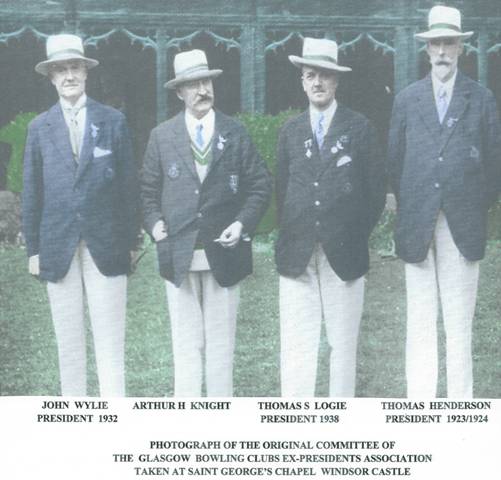
Thomas Logie, of the Ex-Presidents Association, third from left, 1938. Source: Glasgow Bowling Clubs Ex-Presidents Association
The building survived until 1995, latterly as a Co-op Dairy – more on that in another post – before being demolished for the new flats on Titwood Road.
The Gardens
Around 1926 James Wright acquired most of the land of Moray Park, and went on to build Strathbungo’s Gardens. These were finished in 1927-28. Further houses were built by William Todd Aitkenhead immediately after.
James Wright’s planning application to redevelop Moray Park with 170 new houses also serves to confirm beyond doubt the Gardens as the location of Moray Park.
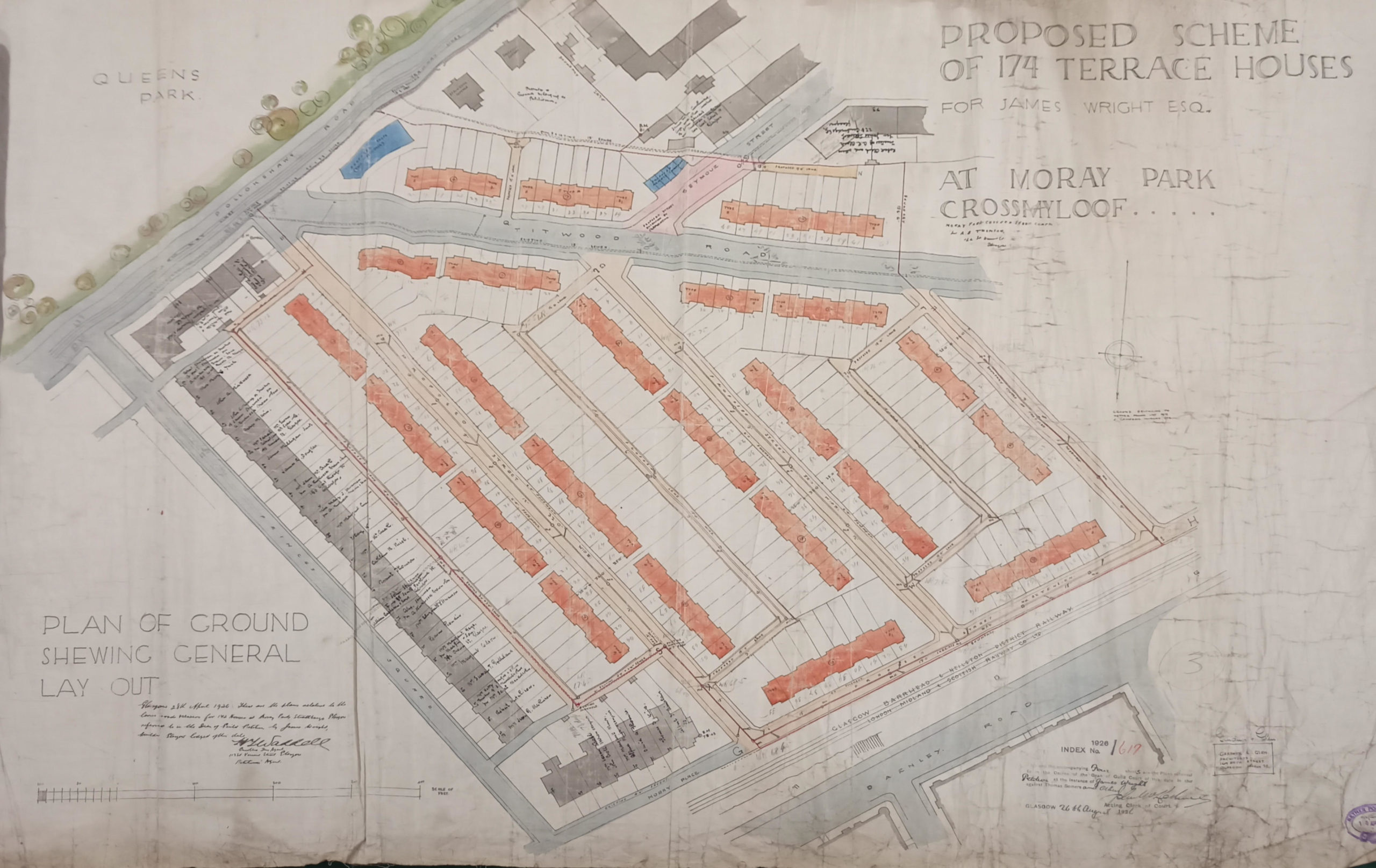
James Wright’s plan for the development of Moray Place, 1926. Source: GCA

Front and rear elevations of the proposed houses for Moray Park, 1926. Source: GCA
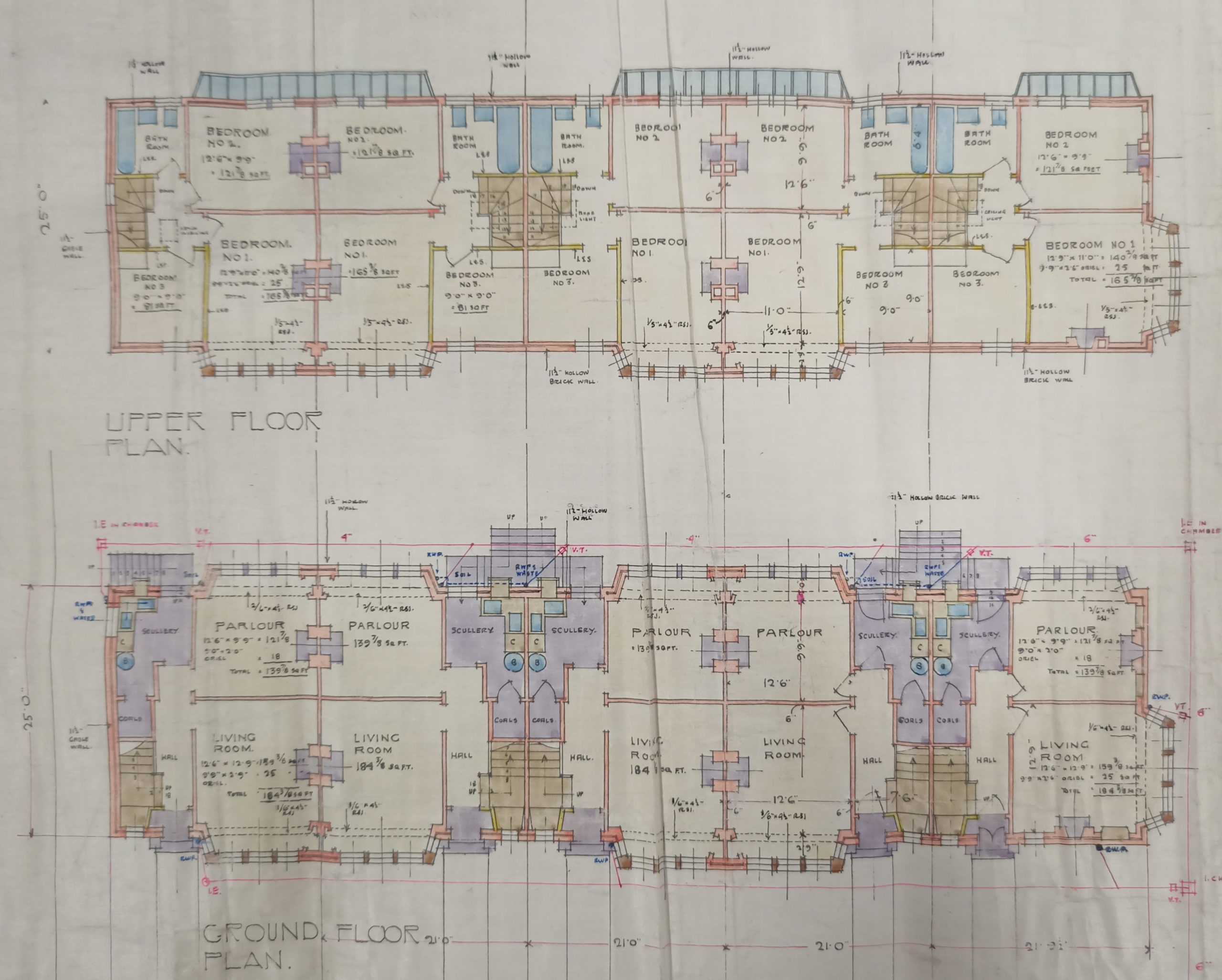
Ground and first floor plans, 1926. Source: GCA
The Strathbungo Society – the death of Moray Park?
The final reference I can find to Moray Park comes in 1971, when residents upset at the plan to demolish parts of Strathbungo for a motorway got together to form “The Regents Park and Moray Park Society” – the name Moray Park was hanging on, though I didn’t recognise its significance when I wrote of that meeting. Robin Haddow, a young architect, objected to the name, and suggested “The Strathbungo Society” instead. He sensibly won the day, and so Moray Park died as The Strathbungo Society was born.
Additions and corrections welcome.
References
{3557955:JBBYMY72};{3557955:D8WZYNAA},{3557955:JUVMXYIX};{3557955:YG587W8K};{3557955:C9JGCWRE};{3557955:C7MELL5E};{3557955:D6D6W5VN},{3557955:9TY3AED7};{3557955:YDSSTD2A},{3557955:3J7FWB3L};{3557955:MAUCTX7Y};{3557955:TCAQBLR9};{3557955:ZG7JX9RT};{3557955:DMTXL3YR};{3557955:QAFHWQ9K};{3557955:XZD2HMUB};{3557955:78MC987T};{3557955:LNL5CIXY},{3557955:8P55TIZF};{3557955:83J28A47};{3557955:3UJQDYC7}
vancouver
asc
0
4480
%7B%22status%22%3A%22success%22%2C%22updateneeded%22%3Afalse%2C%22instance%22%3A%22zotpress-16a51e949783213f0e0c8e33fa947ca8%22%2C%22meta%22%3A%7B%22request_last%22%3A0%2C%22request_next%22%3A0%2C%22used_cache%22%3Atrue%7D%2C%22data%22%3A%5B%7B%22key%22%3A%22D6D6W5VN%22%2C%22library%22%3A%7B%22id%22%3A3557955%7D%2C%22meta%22%3A%7B%22parsedDate%22%3A%221939-02-22%22%2C%22numChildren%22%3A1%7D%2C%22bib%22%3A%22%3Cdiv%20class%3D%5C%22csl-bib-body%5C%22%20style%3D%5C%22line-height%3A%201.35%3B%20%5C%22%3E%5Cn%20%20%3Cdiv%20class%3D%5C%22csl-entry%5C%22%20style%3D%5C%22clear%3A%20left%3B%20%5C%22%3E%5Cn%20%20%20%20%3Cdiv%20class%3D%5C%22csl-left-margin%5C%22%20style%3D%5C%22float%3A%20left%3B%20padding-right%3A%200.5em%3B%20text-align%3A%20right%3B%20width%3A%201em%3B%5C%22%3E1.%3C%5C%2Fdiv%3E%3Cdiv%20class%3D%5C%22csl-right-inline%5C%22%20style%3D%5C%22margin%3A%200%20.4em%200%201.5em%3B%5C%22%3ECartha%20Athletic%20Club%20Jubilee%20Dinner.%20Glasgow%20Herald.%201939%20Feb%2022%3B%3C%5C%2Fdiv%3E%5Cn%20%20%20%3C%5C%2Fdiv%3E%5Cn%3C%5C%2Fdiv%3E%22%2C%22data%22%3A%7B%22itemType%22%3A%22newspaperArticle%22%2C%22title%22%3A%22Cartha%20Athletic%20Club%20Jubilee%20Dinner%22%2C%22creators%22%3A%5B%5D%2C%22abstractNote%22%3A%22%22%2C%22date%22%3A%2222%20Feb%201939%22%2C%22section%22%3A%22%22%2C%22language%22%3A%22%22%2C%22ISSN%22%3A%22%22%2C%22url%22%3A%22%22%2C%22collections%22%3A%5B%22CAR6MXPM%22%5D%2C%22dateModified%22%3A%222023-11-08T19%3A01%3A55Z%22%7D%7D%2C%7B%22key%22%3A%2278MC987T%22%2C%22library%22%3A%7B%22id%22%3A3557955%7D%2C%22meta%22%3A%7B%22numChildren%22%3A1%7D%2C%22bib%22%3A%22%3Cdiv%20class%3D%5C%22csl-bib-body%5C%22%20style%3D%5C%22line-height%3A%201.35%3B%20%5C%22%3E%5Cn%20%20%3Cdiv%20class%3D%5C%22csl-entry%5C%22%20style%3D%5C%22clear%3A%20left%3B%20%5C%22%3E%5Cn%20%20%20%20%3Cdiv%20class%3D%5C%22csl-left-margin%5C%22%20style%3D%5C%22float%3A%20left%3B%20padding-right%3A%200.5em%3B%20text-align%3A%20right%3B%20width%3A%201em%3B%5C%22%3E1.%3C%5C%2Fdiv%3E%3Cdiv%20class%3D%5C%22csl-right-inline%5C%22%20style%3D%5C%22margin%3A%200%20.4em%200%201.5em%3B%5C%22%3ENews%20In%20Brief.%20%7C%20Daily%20Record%20%7C%20Wednesday%2009%20February%201921%20%7C%20British%20Newspaper%20Archive%20%5BInternet%5D.%20%5Bcited%202023%20Oct%2024%5D.%20Available%20from%3A%20%3Ca%20href%3D%27https%3A%5C%2F%5C%2Fwww.britishnewspaperarchive.co.uk%5C%2Fviewer%5C%2FBL%5C%2F0000728%5C%2F19210209%5C%2F042%5C%2F0005%3Fbrowse%3DFalse%27%3Ehttps%3A%5C%2F%5C%2Fwww.britishnewspaperarchive.co.uk%5C%2Fviewer%5C%2FBL%5C%2F0000728%5C%2F19210209%5C%2F042%5C%2F0005%3Fbrowse%3DFalse%3C%5C%2Fa%3E%3C%5C%2Fdiv%3E%5Cn%20%20%3C%5C%2Fdiv%3E%5Cn%3C%5C%2Fdiv%3E%22%2C%22data%22%3A%7B%22itemType%22%3A%22webpage%22%2C%22title%22%3A%22News%20In%20Brief.%20%7C%20Daily%20Record%20%7C%20Wednesday%2009%20February%201921%20%7C%20British%20Newspaper%20Archive%22%2C%22creators%22%3A%5B%5D%2C%22abstractNote%22%3A%22%22%2C%22date%22%3A%22%22%2C%22url%22%3A%22https%3A%5C%2F%5C%2Fwww.britishnewspaperarchive.co.uk%5C%2Fviewer%5C%2FBL%5C%2F0000728%5C%2F19210209%5C%2F042%5C%2F0005%3Fbrowse%3DFalse%22%2C%22language%22%3A%22%22%2C%22collections%22%3A%5B%22CAR6MXPM%22%5D%2C%22dateModified%22%3A%222023-10-24T13%3A01%3A21Z%22%7D%7D%2C%7B%22key%22%3A%22XZD2HMUB%22%2C%22library%22%3A%7B%22id%22%3A3557955%7D%2C%22meta%22%3A%7B%22numChildren%22%3A1%7D%2C%22bib%22%3A%22%3Cdiv%20class%3D%5C%22csl-bib-body%5C%22%20style%3D%5C%22line-height%3A%201.35%3B%20%5C%22%3E%5Cn%20%20%3Cdiv%20class%3D%5C%22csl-entry%5C%22%20style%3D%5C%22clear%3A%20left%3B%20%5C%22%3E%5Cn%20%20%20%20%3Cdiv%20class%3D%5C%22csl-left-margin%5C%22%20style%3D%5C%22float%3A%20left%3B%20padding-right%3A%200.5em%3B%20text-align%3A%20right%3B%20width%3A%201em%3B%5C%22%3E1.%3C%5C%2Fdiv%3E%3Cdiv%20class%3D%5C%22csl-right-inline%5C%22%20style%3D%5C%22margin%3A%200%20.4em%200%201.5em%3B%5C%22%3EBig%20increase%20of%20allotments%20for%20this%20year%20%7C%20Daily%20Record%20%7C%20Wednesday%2006%20February%201918%20%7C%20British%20Newspaper%20Archive%20%5BInternet%5D.%20%5Bcited%202023%20Oct%2024%5D.%20Available%20from%3A%20%3Ca%20href%3D%27https%3A%5C%2F%5C%2Fwww.britishnewspaperarchive.co.uk%5C%2Fviewer%5C%2FBL%5C%2F0000728%5C%2F19180206%5C%2F082%5C%2F0004%3Fbrowse%3DFalse%27%3Ehttps%3A%5C%2F%5C%2Fwww.britishnewspaperarchive.co.uk%5C%2Fviewer%5C%2FBL%5C%2F0000728%5C%2F19180206%5C%2F082%5C%2F0004%3Fbrowse%3DFalse%3C%5C%2Fa%3E%3C%5C%2Fdiv%3E%5Cn%20%20%3C%5C%2Fdiv%3E%5Cn%3C%5C%2Fdiv%3E%22%2C%22data%22%3A%7B%22itemType%22%3A%22webpage%22%2C%22title%22%3A%22Big%20increase%20of%20allotments%20for%20this%20year%20%7C%20Daily%20Record%20%7C%20Wednesday%2006%20February%201918%20%7C%20British%20Newspaper%20Archive%22%2C%22creators%22%3A%5B%5D%2C%22abstractNote%22%3A%22%22%2C%22date%22%3A%22%22%2C%22url%22%3A%22https%3A%5C%2F%5C%2Fwww.britishnewspaperarchive.co.uk%5C%2Fviewer%5C%2FBL%5C%2F0000728%5C%2F19180206%5C%2F082%5C%2F0004%3Fbrowse%3DFalse%22%2C%22language%22%3A%22%22%2C%22collections%22%3A%5B%22CAR6MXPM%22%5D%2C%22dateModified%22%3A%222023-10-24T09%3A02%3A57Z%22%7D%7D%2C%7B%22key%22%3A%22QAFHWQ9K%22%2C%22library%22%3A%7B%22id%22%3A3557955%7D%2C%22meta%22%3A%7B%22numChildren%22%3A1%7D%2C%22bib%22%3A%22%3Cdiv%20class%3D%5C%22csl-bib-body%5C%22%20style%3D%5C%22line-height%3A%201.35%3B%20%5C%22%3E%5Cn%20%20%3Cdiv%20class%3D%5C%22csl-entry%5C%22%20style%3D%5C%22clear%3A%20left%3B%20%5C%22%3E%5Cn%20%20%20%20%3Cdiv%20class%3D%5C%22csl-left-margin%5C%22%20style%3D%5C%22float%3A%20left%3B%20padding-right%3A%200.5em%3B%20text-align%3A%20right%3B%20width%3A%201em%3B%5C%22%3E1.%3C%5C%2Fdiv%3E%3Cdiv%20class%3D%5C%22csl-right-inline%5C%22%20style%3D%5C%22margin%3A%200%20.4em%200%201.5em%3B%5C%22%3EA%20Grim%20Suicide.%20His%20Own%20Obituary%20and%20Apologia.%20%7C%20Daily%20Record%20%7C%20Wednesday%2007%20April%201909%20%7C%20British%20Newspaper%20Archive%20%5BInternet%5D.%20%5Bcited%202023%20Oct%2024%5D.%20Available%20from%3A%20%3Ca%20href%3D%27https%3A%5C%2F%5C%2Fwww.britishnewspaperarchive.co.uk%5C%2Fviewer%5C%2Fbl%5C%2F0000728%5C%2F19090407%5C%2F035%5C%2F0003%27%3Ehttps%3A%5C%2F%5C%2Fwww.britishnewspaperarchive.co.uk%5C%2Fviewer%5C%2Fbl%5C%2F0000728%5C%2F19090407%5C%2F035%5C%2F0003%3C%5C%2Fa%3E%3C%5C%2Fdiv%3E%5Cn%20%20%3C%5C%2Fdiv%3E%5Cn%3C%5C%2Fdiv%3E%22%2C%22data%22%3A%7B%22itemType%22%3A%22webpage%22%2C%22title%22%3A%22A%20Grim%20Suicide.%20His%20Own%20Obituary%20and%20Apologia.%20%7C%20Daily%20Record%20%7C%20Wednesday%2007%20April%201909%20%7C%20British%20Newspaper%20Archive%22%2C%22creators%22%3A%5B%5D%2C%22abstractNote%22%3A%22%22%2C%22date%22%3A%22%22%2C%22url%22%3A%22https%3A%5C%2F%5C%2Fwww.britishnewspaperarchive.co.uk%5C%2Fviewer%5C%2Fbl%5C%2F0000728%5C%2F19090407%5C%2F035%5C%2F0003%22%2C%22language%22%3A%22%22%2C%22collections%22%3A%5B%22CAR6MXPM%22%5D%2C%22dateModified%22%3A%222023-10-24T09%3A00%3A41Z%22%7D%7D%2C%7B%22key%22%3A%22TCAQBLR9%22%2C%22library%22%3A%7B%22id%22%3A3557955%7D%2C%22meta%22%3A%7B%22numChildren%22%3A1%7D%2C%22bib%22%3A%22%3Cdiv%20class%3D%5C%22csl-bib-body%5C%22%20style%3D%5C%22line-height%3A%201.35%3B%20%5C%22%3E%5Cn%20%20%3Cdiv%20class%3D%5C%22csl-entry%5C%22%20style%3D%5C%22clear%3A%20left%3B%20%5C%22%3E%5Cn%20%20%20%20%3Cdiv%20class%3D%5C%22csl-left-margin%5C%22%20style%3D%5C%22float%3A%20left%3B%20padding-right%3A%200.5em%3B%20text-align%3A%20right%3B%20width%3A%201em%3B%5C%22%3E1.%3C%5C%2Fdiv%3E%3Cdiv%20class%3D%5C%22csl-right-inline%5C%22%20style%3D%5C%22margin%3A%200%20.4em%200%201.5em%3B%5C%22%3ECeltic%20monthly%20%26gt%3B%20Volume%205%2C%201897%20-%20Early%20Gaelic%20Book%20Collections%20-%20National%20Library%20of%20Scotland%20%5BInternet%5D.%20%5Bcited%202023%20Oct%2023%5D.%20Available%20from%3A%20%3Ca%20href%3D%27https%3A%5C%2F%5C%2Fdigital.nls.uk%5C%2Fearly-gaelic-book-collections%5C%2Farchive%5C%2F75852072%27%3Ehttps%3A%5C%2F%5C%2Fdigital.nls.uk%5C%2Fearly-gaelic-book-collections%5C%2Farchive%5C%2F75852072%3C%5C%2Fa%3E%3C%5C%2Fdiv%3E%5Cn%20%20%3C%5C%2Fdiv%3E%5Cn%3C%5C%2Fdiv%3E%22%2C%22data%22%3A%7B%22itemType%22%3A%22webpage%22%2C%22title%22%3A%22Celtic%20monthly%20%3E%20Volume%205%2C%201897%20-%20Early%20Gaelic%20Book%20Collections%20-%20National%20Library%20of%20Scotland%22%2C%22creators%22%3A%5B%5D%2C%22abstractNote%22%3A%22%22%2C%22date%22%3A%22%22%2C%22url%22%3A%22https%3A%5C%2F%5C%2Fdigital.nls.uk%5C%2Fearly-gaelic-book-collections%5C%2Farchive%5C%2F75852072%22%2C%22language%22%3A%22%22%2C%22collections%22%3A%5B%22CAR6MXPM%22%5D%2C%22dateModified%22%3A%222023-10-23T22%3A22%3A55Z%22%7D%7D%2C%7B%22key%22%3A%22DMTXL3YR%22%2C%22library%22%3A%7B%22id%22%3A3557955%7D%2C%22meta%22%3A%7B%22numChildren%22%3A1%7D%2C%22bib%22%3A%22%3Cdiv%20class%3D%5C%22csl-bib-body%5C%22%20style%3D%5C%22line-height%3A%201.35%3B%20%5C%22%3E%5Cn%20%20%3Cdiv%20class%3D%5C%22csl-entry%5C%22%20style%3D%5C%22clear%3A%20left%3B%20%5C%22%3E%5Cn%20%20%20%20%3Cdiv%20class%3D%5C%22csl-left-margin%5C%22%20style%3D%5C%22float%3A%20left%3B%20padding-right%3A%200.5em%3B%20text-align%3A%20right%3B%20width%3A%201em%3B%5C%22%3E1.%3C%5C%2Fdiv%3E%3Cdiv%20class%3D%5C%22csl-right-inline%5C%22%20style%3D%5C%22margin%3A%200%20.4em%200%201.5em%3B%5C%22%3EShinty%20-%20Glasgow%20Cowal%20Reserves%20v.%20Edinburgh%20Sutherland.%20%7C%20Oban%20Times%20and%20Argyllshire%20Advertiser%20%7C%20Saturday%2018%20May%201895%20%7C%20British%20Newspaper%20Archive%20%5BInternet%5D.%20%5Bcited%202023%20Oct%2023%5D.%20Available%20from%3A%20%3Ca%20href%3D%27https%3A%5C%2F%5C%2Fwww.britishnewspaperarchive.co.uk%5C%2Fviewer%5C%2Fbl%5C%2F0000462%5C%2F18950518%5C%2F030%5C%2F0002%27%3Ehttps%3A%5C%2F%5C%2Fwww.britishnewspaperarchive.co.uk%5C%2Fviewer%5C%2Fbl%5C%2F0000462%5C%2F18950518%5C%2F030%5C%2F0002%3C%5C%2Fa%3E%3C%5C%2Fdiv%3E%5Cn%20%20%3C%5C%2Fdiv%3E%5Cn%3C%5C%2Fdiv%3E%22%2C%22data%22%3A%7B%22itemType%22%3A%22webpage%22%2C%22title%22%3A%22Shinty%20-%20Glasgow%20Cowal%20Reserves%20v.%20Edinburgh%20Sutherland.%20%7C%20Oban%20Times%20and%20Argyllshire%20Advertiser%20%7C%20Saturday%2018%20May%201895%20%7C%20British%20Newspaper%20Archive%22%2C%22creators%22%3A%5B%5D%2C%22abstractNote%22%3A%22%22%2C%22date%22%3A%22%22%2C%22url%22%3A%22https%3A%5C%2F%5C%2Fwww.britishnewspaperarchive.co.uk%5C%2Fviewer%5C%2Fbl%5C%2F0000462%5C%2F18950518%5C%2F030%5C%2F0002%22%2C%22language%22%3A%22%22%2C%22collections%22%3A%5B%22CAR6MXPM%22%5D%2C%22dateModified%22%3A%222023-10-23T22%3A17%3A19Z%22%7D%7D%2C%7B%22key%22%3A%22ZG7JX9RT%22%2C%22library%22%3A%7B%22id%22%3A3557955%7D%2C%22meta%22%3A%7B%22numChildren%22%3A1%7D%2C%22bib%22%3A%22%3Cdiv%20class%3D%5C%22csl-bib-body%5C%22%20style%3D%5C%22line-height%3A%201.35%3B%20%5C%22%3E%5Cn%20%20%3Cdiv%20class%3D%5C%22csl-entry%5C%22%20style%3D%5C%22clear%3A%20left%3B%20%5C%22%3E%5Cn%20%20%20%20%3Cdiv%20class%3D%5C%22csl-left-margin%5C%22%20style%3D%5C%22float%3A%20left%3B%20padding-right%3A%200.5em%3B%20text-align%3A%20right%3B%20width%3A%201em%3B%5C%22%3E1.%3C%5C%2Fdiv%3E%3Cdiv%20class%3D%5C%22csl-right-inline%5C%22%20style%3D%5C%22margin%3A%200%20.4em%200%201.5em%3B%5C%22%3EGlasgow%20Cowal%20Shinty%20Match.%20%7C%20Oban%20Times%20and%20Argyllshire%20Advertiser%20%7C%20Saturday%2009%20January%201897%20%7C%20British%20Newspaper%20Archive%20%5BInternet%5D.%20%5Bcited%202023%20Oct%2023%5D.%20Available%20from%3A%20%3Ca%20href%3D%27https%3A%5C%2F%5C%2Fwww.britishnewspaperarchive.co.uk%5C%2Fviewer%5C%2Fbl%5C%2F0000462%5C%2F18970109%5C%2F118%5C%2F0005%27%3Ehttps%3A%5C%2F%5C%2Fwww.britishnewspaperarchive.co.uk%5C%2Fviewer%5C%2Fbl%5C%2F0000462%5C%2F18970109%5C%2F118%5C%2F0005%3C%5C%2Fa%3E%3C%5C%2Fdiv%3E%5Cn%20%20%3C%5C%2Fdiv%3E%5Cn%3C%5C%2Fdiv%3E%22%2C%22data%22%3A%7B%22itemType%22%3A%22webpage%22%2C%22title%22%3A%22Glasgow%20Cowal%20Shinty%20Match.%20%7C%20Oban%20Times%20and%20Argyllshire%20Advertiser%20%7C%20Saturday%2009%20January%201897%20%7C%20British%20Newspaper%20Archive%22%2C%22creators%22%3A%5B%5D%2C%22abstractNote%22%3A%22%22%2C%22date%22%3A%22%22%2C%22url%22%3A%22https%3A%5C%2F%5C%2Fwww.britishnewspaperarchive.co.uk%5C%2Fviewer%5C%2Fbl%5C%2F0000462%5C%2F18970109%5C%2F118%5C%2F0005%22%2C%22language%22%3A%22%22%2C%22collections%22%3A%5B%22CAR6MXPM%22%5D%2C%22dateModified%22%3A%222023-10-23T22%3A15%3A45Z%22%7D%7D%2C%7B%22key%22%3A%22YDSSTD2A%22%2C%22library%22%3A%7B%22id%22%3A3557955%7D%2C%22meta%22%3A%7B%22parsedDate%22%3A%221927-08-20%22%2C%22numChildren%22%3A1%7D%2C%22bib%22%3A%22%3Cdiv%20class%3D%5C%22csl-bib-body%5C%22%20style%3D%5C%22line-height%3A%201.35%3B%20%5C%22%3E%5Cn%20%20%3Cdiv%20class%3D%5C%22csl-entry%5C%22%20style%3D%5C%22clear%3A%20left%3B%20%5C%22%3E%5Cn%20%20%20%20%3Cdiv%20class%3D%5C%22csl-left-margin%5C%22%20style%3D%5C%22float%3A%20left%3B%20padding-right%3A%200.5em%3B%20text-align%3A%20right%3B%20width%3A%201em%3B%5C%22%3E1.%3C%5C%2Fdiv%3E%3Cdiv%20class%3D%5C%22csl-right-inline%5C%22%20style%3D%5C%22margin%3A%200%20.4em%200%201.5em%3B%5C%22%3EShinty%20and%20Hockey.%20Daily%20Standard%20%5BInternet%5D.%201927%20Aug%2020%20%5Bcited%202023%20Oct%2023%5D%3B%20Available%20from%3A%20%3Ca%20href%3D%27http%3A%5C%2F%5C%2Fnla.gov.au%5C%2Fnla.news-article184909418%27%3Ehttp%3A%5C%2F%5C%2Fnla.gov.au%5C%2Fnla.news-article184909418%3C%5C%2Fa%3E%3C%5C%2Fdiv%3E%5Cn%20%20%3C%5C%2Fdiv%3E%5Cn%3C%5C%2Fdiv%3E%22%2C%22data%22%3A%7B%22itemType%22%3A%22newspaperArticle%22%2C%22title%22%3A%22Shinty%20and%20Hockey%22%2C%22creators%22%3A%5B%5D%2C%22abstractNote%22%3A%22%5C%22I%20DON%27T%20know%20much%20about%20hockey%20nowadays%2C%5C%22%20confessed%20Mayor%20Jolly%2C%20at%20the%20civic%20reception%20to%20visiting%20hockey%20teams%20yesterday.%20%5C%22As%20a%20...%22%2C%22date%22%3A%2220%20Aug%201927%22%2C%22section%22%3A%22%22%2C%22language%22%3A%22%22%2C%22ISSN%22%3A%22%22%2C%22url%22%3A%22http%3A%5C%2F%5C%2Fnla.gov.au%5C%2Fnla.news-article184909418%22%2C%22collections%22%3A%5B%22CAR6MXPM%22%5D%2C%22dateModified%22%3A%222023-10-23T16%3A12%3A59Z%22%7D%7D%2C%7B%22key%22%3A%22JBBYMY72%22%2C%22library%22%3A%7B%22id%22%3A3557955%7D%2C%22meta%22%3A%7B%22creatorSummary%22%3A%22Robertson%22%2C%22parsedDate%22%3A%221949%22%2C%22numChildren%22%3A1%7D%2C%22bib%22%3A%22%3Cdiv%20class%3D%5C%22csl-bib-body%5C%22%20style%3D%5C%22line-height%3A%201.35%3B%20%5C%22%3E%5Cn%20%20%3Cdiv%20class%3D%5C%22csl-entry%5C%22%20style%3D%5C%22clear%3A%20left%3B%20%5C%22%3E%5Cn%20%20%20%20%3Cdiv%20class%3D%5C%22csl-left-margin%5C%22%20style%3D%5C%22float%3A%20left%3B%20padding-right%3A%200.5em%3B%20text-align%3A%20right%3B%20width%3A%201em%3B%5C%22%3E1.%3C%5C%2Fdiv%3E%3Cdiv%20class%3D%5C%22csl-right-inline%5C%22%20style%3D%5C%22margin%3A%200%20.4em%200%201.5em%3B%5C%22%3ERobertson%20AS.%20Roman%20Coins%20found%20in%20scotland.%20Proceedings%20of%20the%20Society%20of%20Antiquaries%20of%20Scotland%20%5BInternet%5D.%201949%2050%3B84%3A137%26%23x2013%3B69.%20Available%20from%3A%20%3Ca%20href%3D%27https%3A%5C%2F%5C%2Farchaeologydataservice.ac.uk%5C%2Farchives%5C%2Fview%5C%2Fpsas%5C%2Fcontents.cfm%3Fvol%3D84%27%3Ehttps%3A%5C%2F%5C%2Farchaeologydataservice.ac.uk%5C%2Farchives%5C%2Fview%5C%2Fpsas%5C%2Fcontents.cfm%3Fvol%3D84%3C%5C%2Fa%3E%3C%5C%2Fdiv%3E%5Cn%20%20%3C%5C%2Fdiv%3E%5Cn%3C%5C%2Fdiv%3E%22%2C%22data%22%3A%7B%22itemType%22%3A%22journalArticle%22%2C%22title%22%3A%22Roman%20Coins%20found%20in%20scotland%22%2C%22creators%22%3A%5B%7B%22creatorType%22%3A%22author%22%2C%22firstName%22%3A%22Anne%20S%22%2C%22lastName%22%3A%22Robertson%22%7D%5D%2C%22abstractNote%22%3A%22%22%2C%22date%22%3A%221949-50%22%2C%22language%22%3A%22en%22%2C%22DOI%22%3A%22%22%2C%22ISSN%22%3A%22%22%2C%22url%22%3A%22https%3A%5C%2F%5C%2Farchaeologydataservice.ac.uk%5C%2Farchives%5C%2Fview%5C%2Fpsas%5C%2Fcontents.cfm%3Fvol%3D84%22%2C%22collections%22%3A%5B%22CAR6MXPM%22%5D%2C%22dateModified%22%3A%222023-10-23T15%3A16%3A07Z%22%7D%7D%2C%7B%22key%22%3A%22C9JGCWRE%22%2C%22library%22%3A%7B%22id%22%3A3557955%7D%2C%22meta%22%3A%7B%22parsedDate%22%3A%222023-10-22%22%2C%22numChildren%22%3A0%7D%2C%22bib%22%3A%22%3Cdiv%20class%3D%5C%22csl-bib-body%5C%22%20style%3D%5C%22line-height%3A%201.35%3B%20%5C%22%3E%5Cn%20%20%3Cdiv%20class%3D%5C%22csl-entry%5C%22%20style%3D%5C%22clear%3A%20left%3B%20%5C%22%3E%5Cn%20%20%20%20%3Cdiv%20class%3D%5C%22csl-left-margin%5C%22%20style%3D%5C%22float%3A%20left%3B%20padding-right%3A%200.5em%3B%20text-align%3A%20right%3B%20width%3A%201em%3B%5C%22%3E1.%3C%5C%2Fdiv%3E%3Cdiv%20class%3D%5C%22csl-right-inline%5C%22%20style%3D%5C%22margin%3A%200%20.4em%200%201.5em%3B%5C%22%3EList%20of%20minor%20Scottish%20Cup%20entrants%20%281873%26%23x2013%3B1894%29.%20In%3A%20Wikipedia%20%5BInternet%5D.%202023%20%5Bcited%202023%20Oct%2023%5D.%20Available%20from%3A%20%3Ca%20href%3D%27https%3A%5C%2F%5C%2Fen.wikipedia.org%5C%2Fw%5C%2Findex.php%3Ftitle%3DList_of_minor_Scottish_Cup_entrants_%281873%25E2%2580%25931894%29%26oldid%3D1181341135%23Cambridge_F.C.%27%3Ehttps%3A%5C%2F%5C%2Fen.wikipedia.org%5C%2Fw%5C%2Findex.php%3Ftitle%3DList_of_minor_Scottish_Cup_entrants_%281873%25E2%2580%25931894%29%26oldid%3D1181341135%23Cambridge_F.C.%3C%5C%2Fa%3E%3C%5C%2Fdiv%3E%5Cn%20%20%3C%5C%2Fdiv%3E%5Cn%3C%5C%2Fdiv%3E%22%2C%22data%22%3A%7B%22itemType%22%3A%22encyclopediaArticle%22%2C%22title%22%3A%22List%20of%20minor%20Scottish%20Cup%20entrants%20%281873%5Cu20131894%29%22%2C%22creators%22%3A%5B%5D%2C%22abstractNote%22%3A%22This%20is%20a%20list%20of%20association%20football%20clubs%20which%20entered%20the%20Scottish%20Cup%20between%201873%20and%201894%2C%20when%20the%20Scottish%20Qualifying%20Cup%20was%20introduced%2C%20and%20which%20lack%20the%20prominence%20for%20their%20Wikipedia%20pages.%22%2C%22encyclopediaTitle%22%3A%22Wikipedia%22%2C%22date%22%3A%222023-10-22T13%3A07%3A26Z%22%2C%22ISBN%22%3A%22%22%2C%22url%22%3A%22https%3A%5C%2F%5C%2Fen.wikipedia.org%5C%2Fw%5C%2Findex.php%3Ftitle%3DList_of_minor_Scottish_Cup_entrants_%281873%25E2%2580%25931894%29%26oldid%3D1181341135%23Cambridge_F.C.%22%2C%22language%22%3A%22en%22%2C%22collections%22%3A%5B%22CAR6MXPM%22%5D%2C%22dateModified%22%3A%222023-10-23T14%3A51%3A07Z%22%7D%7D%2C%7B%22key%22%3A%22YG587W8K%22%2C%22library%22%3A%7B%22id%22%3A3557955%7D%2C%22meta%22%3A%7B%22numChildren%22%3A1%7D%2C%22bib%22%3A%22%3Cdiv%20class%3D%5C%22csl-bib-body%5C%22%20style%3D%5C%22line-height%3A%201.35%3B%20%5C%22%3E%5Cn%20%20%3Cdiv%20class%3D%5C%22csl-entry%5C%22%20style%3D%5C%22clear%3A%20left%3B%20%5C%22%3E%5Cn%20%20%20%20%3Cdiv%20class%3D%5C%22csl-left-margin%5C%22%20style%3D%5C%22float%3A%20left%3B%20padding-right%3A%200.5em%3B%20text-align%3A%20right%3B%20width%3A%201em%3B%5C%22%3E1.%3C%5C%2Fdiv%3E%3Cdiv%20class%3D%5C%22csl-right-inline%5C%22%20style%3D%5C%22margin%3A%200%20.4em%200%201.5em%3B%5C%22%3EHousebreaking%20%7C%20Paisley%20Daily%20Express%20%7C%20Wednesday%2014%20July%201886%20%7C%20British%20Newspaper%20Archive%20%5BInternet%5D.%20%5Bcited%202023%20Oct%2023%5D.%20Available%20from%3A%20%3Ca%20href%3D%27https%3A%5C%2F%5C%2Fwww.britishnewspaperarchive.co.uk%5C%2Fviewer%5C%2FBL%5C%2F0001713%5C%2F18860714%5C%2F002%5C%2F0002%3Fbrowse%3DFalse%27%3Ehttps%3A%5C%2F%5C%2Fwww.britishnewspaperarchive.co.uk%5C%2Fviewer%5C%2FBL%5C%2F0001713%5C%2F18860714%5C%2F002%5C%2F0002%3Fbrowse%3DFalse%3C%5C%2Fa%3E%3C%5C%2Fdiv%3E%5Cn%20%20%3C%5C%2Fdiv%3E%5Cn%3C%5C%2Fdiv%3E%22%2C%22data%22%3A%7B%22itemType%22%3A%22webpage%22%2C%22title%22%3A%22Housebreaking%20%7C%20Paisley%20Daily%20Express%20%7C%20Wednesday%2014%20July%201886%20%7C%20British%20Newspaper%20Archive%22%2C%22creators%22%3A%5B%5D%2C%22abstractNote%22%3A%22%22%2C%22date%22%3A%22%22%2C%22url%22%3A%22https%3A%5C%2F%5C%2Fwww.britishnewspaperarchive.co.uk%5C%2Fviewer%5C%2FBL%5C%2F0001713%5C%2F18860714%5C%2F002%5C%2F0002%3Fbrowse%3DFalse%22%2C%22language%22%3A%22%22%2C%22collections%22%3A%5B%22CAR6MXPM%22%5D%2C%22dateModified%22%3A%222023-10-23T14%3A37%3A59Z%22%7D%7D%2C%7B%22key%22%3A%22D8WZYNAA%22%2C%22library%22%3A%7B%22id%22%3A3557955%7D%2C%22meta%22%3A%7B%22numChildren%22%3A1%7D%2C%22bib%22%3A%22%3Cdiv%20class%3D%5C%22csl-bib-body%5C%22%20style%3D%5C%22line-height%3A%201.35%3B%20%5C%22%3E%5Cn%20%20%3Cdiv%20class%3D%5C%22csl-entry%5C%22%20style%3D%5C%22clear%3A%20left%3B%20%5C%22%3E%5Cn%20%20%20%20%3Cdiv%20class%3D%5C%22csl-left-margin%5C%22%20style%3D%5C%22float%3A%20left%3B%20padding-right%3A%200.5em%3B%20text-align%3A%20right%3B%20width%3A%201em%3B%5C%22%3E1.%3C%5C%2Fdiv%3E%3Cdiv%20class%3D%5C%22csl-right-inline%5C%22%20style%3D%5C%22margin%3A%200%20.4em%200%201.5em%3B%5C%22%3ERounders.%20%7C%20North%20British%20Daily%20Mail%20%7C%20Tuesday%2031%20March%201885%20%7C%20British%20Newspaper%20Archive%20%5BInternet%5D.%20%5Bcited%202023%20Oct%2023%5D.%20Available%20from%3A%20%3Ca%20href%3D%27https%3A%5C%2F%5C%2Fwww.britishnewspaperarchive.co.uk%5C%2Fviewer%5C%2Fbl%5C%2F0002683%5C%2F18850331%5C%2F097%5C%2F0006%27%3Ehttps%3A%5C%2F%5C%2Fwww.britishnewspaperarchive.co.uk%5C%2Fviewer%5C%2Fbl%5C%2F0002683%5C%2F18850331%5C%2F097%5C%2F0006%3C%5C%2Fa%3E%3C%5C%2Fdiv%3E%5Cn%20%20%3C%5C%2Fdiv%3E%5Cn%3C%5C%2Fdiv%3E%22%2C%22data%22%3A%7B%22itemType%22%3A%22webpage%22%2C%22title%22%3A%22Rounders.%20%7C%20North%20British%20Daily%20Mail%20%7C%20Tuesday%2031%20March%201885%20%7C%20British%20Newspaper%20Archive%22%2C%22creators%22%3A%5B%5D%2C%22abstractNote%22%3A%22%22%2C%22date%22%3A%22%22%2C%22url%22%3A%22https%3A%5C%2F%5C%2Fwww.britishnewspaperarchive.co.uk%5C%2Fviewer%5C%2Fbl%5C%2F0002683%5C%2F18850331%5C%2F097%5C%2F0006%22%2C%22language%22%3A%22%22%2C%22collections%22%3A%5B%22CAR6MXPM%22%5D%2C%22dateModified%22%3A%222023-10-23T14%3A32%3A40Z%22%7D%7D%2C%7B%22key%22%3A%22JUVMXYIX%22%2C%22library%22%3A%7B%22id%22%3A3557955%7D%2C%22meta%22%3A%7B%22numChildren%22%3A1%7D%2C%22bib%22%3A%22%3Cdiv%20class%3D%5C%22csl-bib-body%5C%22%20style%3D%5C%22line-height%3A%201.35%3B%20%5C%22%3E%5Cn%20%20%3Cdiv%20class%3D%5C%22csl-entry%5C%22%20style%3D%5C%22clear%3A%20left%3B%20%5C%22%3E%5Cn%20%20%20%20%3Cdiv%20class%3D%5C%22csl-left-margin%5C%22%20style%3D%5C%22float%3A%20left%3B%20padding-right%3A%200.5em%3B%20text-align%3A%20right%3B%20width%3A%201em%3B%5C%22%3E1.%3C%5C%2Fdiv%3E%3Cdiv%20class%3D%5C%22csl-right-inline%5C%22%20style%3D%5C%22margin%3A%200%20.4em%200%201.5em%3B%5C%22%3ERounders.%20%7C%20North%20British%20Daily%20Mail%20%7C%20Monday%2017%20May%201886%20%7C%20British%20Newspaper%20Archive%20%5BInternet%5D.%20%5Bcited%202023%20Oct%2023%5D.%20Available%20from%3A%20%3Ca%20href%3D%27https%3A%5C%2F%5C%2Fwww.britishnewspaperarchive.co.uk%5C%2Fviewer%5C%2Fbl%5C%2F0002683%5C%2F18860517%5C%2F050%5C%2F0002%27%3Ehttps%3A%5C%2F%5C%2Fwww.britishnewspaperarchive.co.uk%5C%2Fviewer%5C%2Fbl%5C%2F0002683%5C%2F18860517%5C%2F050%5C%2F0002%3C%5C%2Fa%3E%3C%5C%2Fdiv%3E%5Cn%20%20%3C%5C%2Fdiv%3E%5Cn%3C%5C%2Fdiv%3E%22%2C%22data%22%3A%7B%22itemType%22%3A%22webpage%22%2C%22title%22%3A%22Rounders.%20%7C%20North%20British%20Daily%20Mail%20%7C%20Monday%2017%20May%201886%20%7C%20British%20Newspaper%20Archive%22%2C%22creators%22%3A%5B%5D%2C%22abstractNote%22%3A%22%22%2C%22date%22%3A%22%22%2C%22url%22%3A%22https%3A%5C%2F%5C%2Fwww.britishnewspaperarchive.co.uk%5C%2Fviewer%5C%2Fbl%5C%2F0002683%5C%2F18860517%5C%2F050%5C%2F0002%22%2C%22language%22%3A%22%22%2C%22collections%22%3A%5B%22CAR6MXPM%22%5D%2C%22dateModified%22%3A%222023-10-23T14%3A31%3A27Z%22%7D%7D%2C%7B%22key%22%3A%223J7FWB3L%22%2C%22library%22%3A%7B%22id%22%3A3557955%7D%2C%22meta%22%3A%7B%22parsedDate%22%3A%221927-08-25%22%2C%22numChildren%22%3A1%7D%2C%22bib%22%3A%22%3Cdiv%20class%3D%5C%22csl-bib-body%5C%22%20style%3D%5C%22line-height%3A%201.35%3B%20%5C%22%3E%5Cn%20%20%3Cdiv%20class%3D%5C%22csl-entry%5C%22%20style%3D%5C%22clear%3A%20left%3B%20%5C%22%3E%5Cn%20%20%20%20%3Cdiv%20class%3D%5C%22csl-left-margin%5C%22%20style%3D%5C%22float%3A%20left%3B%20padding-right%3A%200.5em%3B%20text-align%3A%20right%3B%20width%3A%201em%3B%5C%22%3E1.%3C%5C%2Fdiv%3E%3Cdiv%20class%3D%5C%22csl-right-inline%5C%22%20style%3D%5C%22margin%3A%200%20.4em%200%201.5em%3B%5C%22%3ESandy%20and%20Shinty.%20Daily%20Standard%20%5BInternet%5D.%201927%20Aug%2025%20%5Bcited%202023%20Oct%2022%5D%3B%20Available%20from%3A%20%3Ca%20href%3D%27http%3A%5C%2F%5C%2Fnla.gov.au%5C%2Fnla.news-article184910186%27%3Ehttp%3A%5C%2F%5C%2Fnla.gov.au%5C%2Fnla.news-article184910186%3C%5C%2Fa%3E%3C%5C%2Fdiv%3E%5Cn%20%20%3C%5C%2Fdiv%3E%5Cn%3C%5C%2Fdiv%3E%22%2C%22data%22%3A%7B%22itemType%22%3A%22newspaperArticle%22%2C%22title%22%3A%22Sandy%20and%20Shinty%22%2C%22creators%22%3A%5B%5D%2C%22abstractNote%22%3A%22SANDY%20M%27WHACHLE%20protests.%5Cu2014The%20gowk%20wha%20wrote%20you%20%5C%22Mirror%5C%22%20par%20%5C%22Shinty%20and%20Hockey%5C%22%20%2820%5C%2F8%5C%2F27%29%20should%20gang%20and%20get%20his%20held%20read.%20Imagine%20...%22%2C%22date%22%3A%2225%20Aug%201927%22%2C%22section%22%3A%22%22%2C%22language%22%3A%22%22%2C%22ISSN%22%3A%22%22%2C%22url%22%3A%22http%3A%5C%2F%5C%2Fnla.gov.au%5C%2Fnla.news-article184910186%22%2C%22collections%22%3A%5B%22CAR6MXPM%22%5D%2C%22dateModified%22%3A%222023-10-22T15%3A01%3A57Z%22%7D%7D%2C%7B%22key%22%3A%223UJQDYC7%22%2C%22library%22%3A%7B%22id%22%3A3557955%7D%2C%22meta%22%3A%7B%22numChildren%22%3A0%7D%2C%22bib%22%3A%22%3Cdiv%20class%3D%5C%22csl-bib-body%5C%22%20style%3D%5C%22line-height%3A%201.35%3B%20%5C%22%3E%5Cn%20%20%3Cdiv%20class%3D%5C%22csl-entry%5C%22%20style%3D%5C%22clear%3A%20left%3B%20%5C%22%3E%5Cn%20%20%20%20%3Cdiv%20class%3D%5C%22csl-left-margin%5C%22%20style%3D%5C%22float%3A%20left%3B%20padding-right%3A%200.5em%3B%20text-align%3A%20right%3B%20width%3A%201em%3B%5C%22%3E1.%3C%5C%2Fdiv%3E%3Cdiv%20class%3D%5C%22csl-right-inline%5C%22%20style%3D%5C%22margin%3A%200%20.4em%200%201.5em%3B%5C%22%3EDeath%20Of%20S.b.a.%20Secretary%20%7C%20The%20Scotsman%20%7C%20Saturday%2004%20August%201951%20%7C%20British%20Newspaper%20Archive%20%5BInternet%5D.%20%5Bcited%202023%20Oct%202%5D.%20Available%20from%3A%20%3Ca%20href%3D%27https%3A%5C%2F%5C%2Fwww.britishnewspaperarchive.co.uk%5C%2Fviewer%5C%2Fbl%5C%2F0000540%5C%2F19510804%5C%2F123%5C%2F0004%27%3Ehttps%3A%5C%2F%5C%2Fwww.britishnewspaperarchive.co.uk%5C%2Fviewer%5C%2Fbl%5C%2F0000540%5C%2F19510804%5C%2F123%5C%2F0004%3C%5C%2Fa%3E%3C%5C%2Fdiv%3E%5Cn%20%20%3C%5C%2Fdiv%3E%5Cn%3C%5C%2Fdiv%3E%22%2C%22data%22%3A%7B%22itemType%22%3A%22webpage%22%2C%22title%22%3A%22Death%20Of%20S.b.a.%20Secretary%20%7C%20The%20Scotsman%20%7C%20Saturday%2004%20August%201951%20%7C%20British%20Newspaper%20Archive%22%2C%22creators%22%3A%5B%5D%2C%22abstractNote%22%3A%22%22%2C%22date%22%3A%22%22%2C%22url%22%3A%22https%3A%5C%2F%5C%2Fwww.britishnewspaperarchive.co.uk%5C%2Fviewer%5C%2Fbl%5C%2F0000540%5C%2F19510804%5C%2F123%5C%2F0004%22%2C%22language%22%3A%22%22%2C%22collections%22%3A%5B%22CAR6MXPM%22%5D%2C%22dateModified%22%3A%222023-10-02T11%3A57%3A05Z%22%7D%7D%2C%7B%22key%22%3A%228P55TIZF%22%2C%22library%22%3A%7B%22id%22%3A3557955%7D%2C%22meta%22%3A%7B%22numChildren%22%3A1%7D%2C%22bib%22%3A%22%3Cdiv%20class%3D%5C%22csl-bib-body%5C%22%20style%3D%5C%22line-height%3A%201.35%3B%20%5C%22%3E%5Cn%20%20%3Cdiv%20class%3D%5C%22csl-entry%5C%22%20style%3D%5C%22clear%3A%20left%3B%20%5C%22%3E%5Cn%20%20%20%20%3Cdiv%20class%3D%5C%22csl-left-margin%5C%22%20style%3D%5C%22float%3A%20left%3B%20padding-right%3A%200.5em%3B%20text-align%3A%20right%3B%20width%3A%201em%3B%5C%22%3E1.%3C%5C%2Fdiv%3E%3Cdiv%20class%3D%5C%22csl-right-inline%5C%22%20style%3D%5C%22margin%3A%200%20.4em%200%201.5em%3B%5C%22%3EThe%20High-Roofed%20Building%20At%20Moray%20Park%20%7C%20Kinematograph%20Weekly%20%7C%20Thursday%2015%20April%201926%20%7C%20British%20Newspaper%20Archive%20%5BInternet%5D.%20%5Bcited%202023%20Oct%201%5D.%20Available%20from%3A%20%3Ca%20href%3D%27https%3A%5C%2F%5C%2Fwww.britishnewspaperarchive.co.uk%5C%2Fviewer%5C%2FBL%5C%2F0003237%5C%2F19260415%5C%2F517%5C%2F0095%3Fbrowse%3DFalse%27%3Ehttps%3A%5C%2F%5C%2Fwww.britishnewspaperarchive.co.uk%5C%2Fviewer%5C%2FBL%5C%2F0003237%5C%2F19260415%5C%2F517%5C%2F0095%3Fbrowse%3DFalse%3C%5C%2Fa%3E%3C%5C%2Fdiv%3E%5Cn%20%20%3C%5C%2Fdiv%3E%5Cn%3C%5C%2Fdiv%3E%22%2C%22data%22%3A%7B%22itemType%22%3A%22webpage%22%2C%22title%22%3A%22The%20High-Roofed%20Building%20At%20Moray%20Park%20%7C%20Kinematograph%20Weekly%20%7C%20Thursday%2015%20April%201926%20%7C%20British%20Newspaper%20Archive%22%2C%22creators%22%3A%5B%5D%2C%22abstractNote%22%3A%22%22%2C%22date%22%3A%22%22%2C%22url%22%3A%22https%3A%5C%2F%5C%2Fwww.britishnewspaperarchive.co.uk%5C%2Fviewer%5C%2FBL%5C%2F0003237%5C%2F19260415%5C%2F517%5C%2F0095%3Fbrowse%3DFalse%22%2C%22language%22%3A%22%22%2C%22collections%22%3A%5B%22CAR6MXPM%22%5D%2C%22dateModified%22%3A%222023-10-01T19%3A50%3A27Z%22%7D%7D%2C%7B%22key%22%3A%22LNL5CIXY%22%2C%22library%22%3A%7B%22id%22%3A3557955%7D%2C%22meta%22%3A%7B%22numChildren%22%3A1%7D%2C%22bib%22%3A%22%3Cdiv%20class%3D%5C%22csl-bib-body%5C%22%20style%3D%5C%22line-height%3A%201.35%3B%20%5C%22%3E%5Cn%20%20%3Cdiv%20class%3D%5C%22csl-entry%5C%22%20style%3D%5C%22clear%3A%20left%3B%20%5C%22%3E%5Cn%20%20%20%20%3Cdiv%20class%3D%5C%22csl-left-margin%5C%22%20style%3D%5C%22float%3A%20left%3B%20padding-right%3A%200.5em%3B%20text-align%3A%20right%3B%20width%3A%201em%3B%5C%22%3E1.%3C%5C%2Fdiv%3E%3Cdiv%20class%3D%5C%22csl-right-inline%5C%22%20style%3D%5C%22margin%3A%200%20.4em%200%201.5em%3B%5C%22%3EThe%20Glasgow%20Area%20%7C%20Kinematograph%20Weekly%20%7C%20Thursday%2001%20April%201926%20%7C%20British%20Newspaper%20Archive%20%5BInternet%5D.%20%5Bcited%202023%20Oct%201%5D.%20Available%20from%3A%20%3Ca%20href%3D%27https%3A%5C%2F%5C%2Fwww.britishnewspaperarchive.co.uk%5C%2Fviewer%5C%2FBL%5C%2F0003237%5C%2F19260401%5C%2F293%5C%2F0045%3Fbrowse%3DFalse%27%3Ehttps%3A%5C%2F%5C%2Fwww.britishnewspaperarchive.co.uk%5C%2Fviewer%5C%2FBL%5C%2F0003237%5C%2F19260401%5C%2F293%5C%2F0045%3Fbrowse%3DFalse%3C%5C%2Fa%3E%3C%5C%2Fdiv%3E%5Cn%20%20%3C%5C%2Fdiv%3E%5Cn%3C%5C%2Fdiv%3E%22%2C%22data%22%3A%7B%22itemType%22%3A%22webpage%22%2C%22title%22%3A%22The%20Glasgow%20Area%20%7C%20Kinematograph%20Weekly%20%7C%20Thursday%2001%20April%201926%20%7C%20British%20Newspaper%20Archive%22%2C%22creators%22%3A%5B%5D%2C%22abstractNote%22%3A%22%22%2C%22date%22%3A%22%22%2C%22url%22%3A%22https%3A%5C%2F%5C%2Fwww.britishnewspaperarchive.co.uk%5C%2Fviewer%5C%2FBL%5C%2F0003237%5C%2F19260401%5C%2F293%5C%2F0045%3Fbrowse%3DFalse%22%2C%22language%22%3A%22%22%2C%22collections%22%3A%5B%22CAR6MXPM%22%5D%2C%22dateModified%22%3A%222023-10-01T19%3A48%3A51Z%22%7D%7D%2C%7B%22key%22%3A%22C7MELL5E%22%2C%22library%22%3A%7B%22id%22%3A3557955%7D%2C%22meta%22%3A%7B%22creatorSummary%22%3A%22Beattie%22%2C%22numChildren%22%3A1%7D%2C%22bib%22%3A%22%3Cdiv%20class%3D%5C%22csl-bib-body%5C%22%20style%3D%5C%22line-height%3A%201.35%3B%20%5C%22%3E%5Cn%20%20%3Cdiv%20class%3D%5C%22csl-entry%5C%22%20style%3D%5C%22clear%3A%20left%3B%20%5C%22%3E%5Cn%20%20%20%20%3Cdiv%20class%3D%5C%22csl-left-margin%5C%22%20style%3D%5C%22float%3A%20left%3B%20padding-right%3A%200.5em%3B%20text-align%3A%20right%3B%20width%3A%201em%3B%5C%22%3E1.%3C%5C%2Fdiv%3E%3Cdiv%20class%3D%5C%22csl-right-inline%5C%22%20style%3D%5C%22margin%3A%200%20.4em%200%201.5em%3B%5C%22%3EBeattie%20A.%20George%20Morrell%20%281871-1931%29%20-%20Find%20a%20Grave%20%5BInternet%5D.%20%5Bcited%202023%20Oct%201%5D.%20Available%20from%3A%20%3Ca%20href%3D%27https%3A%5C%2F%5C%2Fwww.findagrave.com%5C%2Fmemorial%5C%2F130216626%5C%2Fgeorge-morrell%27%3Ehttps%3A%5C%2F%5C%2Fwww.findagrave.com%5C%2Fmemorial%5C%2F130216626%5C%2Fgeorge-morrell%3C%5C%2Fa%3E%3C%5C%2Fdiv%3E%5Cn%20%20%3C%5C%2Fdiv%3E%5Cn%3C%5C%2Fdiv%3E%22%2C%22data%22%3A%7B%22itemType%22%3A%22webpage%22%2C%22title%22%3A%22George%20Morrell%20%281871-1931%29%20-%20Find%20a%20Grave%22%2C%22creators%22%3A%5B%7B%22creatorType%22%3A%22author%22%2C%22firstName%22%3A%22A%22%2C%22lastName%22%3A%22Beattie%22%7D%5D%2C%22abstractNote%22%3A%22%22%2C%22date%22%3A%22%22%2C%22url%22%3A%22https%3A%5C%2F%5C%2Fwww.findagrave.com%5C%2Fmemorial%5C%2F130216626%5C%2Fgeorge-morrell%22%2C%22language%22%3A%22en%22%2C%22collections%22%3A%5B%22CAR6MXPM%22%5D%2C%22dateModified%22%3A%222023-10-01T19%3A47%3A51Z%22%7D%7D%2C%7B%22key%22%3A%229TY3AED7%22%2C%22library%22%3A%7B%22id%22%3A3557955%7D%2C%22meta%22%3A%7B%22creatorSummary%22%3A%22Young%22%2C%22numChildren%22%3A1%7D%2C%22bib%22%3A%22%3Cdiv%20class%3D%5C%22csl-bib-body%5C%22%20style%3D%5C%22line-height%3A%201.35%3B%20%5C%22%3E%5Cn%20%20%3Cdiv%20class%3D%5C%22csl-entry%5C%22%20style%3D%5C%22clear%3A%20left%3B%20%5C%22%3E%5Cn%20%20%20%20%3Cdiv%20class%3D%5C%22csl-left-margin%5C%22%20style%3D%5C%22float%3A%20left%3B%20padding-right%3A%200.5em%3B%20text-align%3A%20right%3B%20width%3A%201em%3B%5C%22%3E1.%3C%5C%2Fdiv%3E%3Cdiv%20class%3D%5C%22csl-right-inline%5C%22%20style%3D%5C%22margin%3A%200%20.4em%200%201.5em%3B%5C%22%3EYoung%20D.%20calameo.com.%20%5Bcited%202023%20Oct%201%5D.%20Cartha%20Queen%26%23x2019%3Bs%20Park%20Rugby%20Football%20Clubs%20History.%20Available%20from%3A%20%3Ca%20href%3D%27https%3A%5C%2F%5C%2Fwww.calameo.com%5C%2Fbooks%5C%2F0048072993eda9c390134%27%3Ehttps%3A%5C%2F%5C%2Fwww.calameo.com%5C%2Fbooks%5C%2F0048072993eda9c390134%3C%5C%2Fa%3E%3C%5C%2Fdiv%3E%5Cn%20%20%3C%5C%2Fdiv%3E%5Cn%3C%5C%2Fdiv%3E%22%2C%22data%22%3A%7B%22itemType%22%3A%22webpage%22%2C%22title%22%3A%22Cartha%20Queen%27s%20Park%20Rugby%20Football%20Clubs%20History%22%2C%22creators%22%3A%5B%7B%22creatorType%22%3A%22author%22%2C%22firstName%22%3A%22Daniel%22%2C%22lastName%22%3A%22Young%22%7D%5D%2C%22abstractNote%22%3A%22%22%2C%22date%22%3A%22%22%2C%22url%22%3A%22https%3A%5C%2F%5C%2Fwww.calameo.com%5C%2Fbooks%5C%2F0048072993eda9c390134%22%2C%22language%22%3A%22en%22%2C%22collections%22%3A%5B%22CAR6MXPM%22%5D%2C%22dateModified%22%3A%222023-10-01T19%3A27%3A47Z%22%7D%7D%2C%7B%22key%22%3A%22MAUCTX7Y%22%2C%22library%22%3A%7B%22id%22%3A3557955%7D%2C%22meta%22%3A%7B%22creatorSummary%22%3A%22McDowall%2C%20John%20K%22%2C%22parsedDate%22%3A%221899%22%2C%22numChildren%22%3A0%7D%2C%22bib%22%3A%22%3Cdiv%20class%3D%5C%22csl-bib-body%5C%22%20style%3D%5C%22line-height%3A%201.35%3B%20%5C%22%3E%5Cn%20%20%3Cdiv%20class%3D%5C%22csl-entry%5C%22%20style%3D%5C%22clear%3A%20left%3B%20%5C%22%3E%5Cn%20%20%20%20%3Cdiv%20class%3D%5C%22csl-left-margin%5C%22%20style%3D%5C%22float%3A%20left%3B%20padding-right%3A%200.5em%3B%20text-align%3A%20right%3B%20width%3A%201em%3B%5C%22%3E1.%3C%5C%2Fdiv%3E%3Cdiv%20class%3D%5C%22csl-right-inline%5C%22%20style%3D%5C%22margin%3A%200%20.4em%200%201.5em%3B%5C%22%3EMcDowall%2C%20John%20K.%20People%26%23x2019%3Bs%20history%20of%20Glasgow%26%23x202F%3B%3A%20an%20encyclopedic%20record%20of%20the%20city%20from%20the%20prehistoric%20to%20the%20present%20day%20%5BInternet%5D.%20Hay%20Nisbet%20%26amp%3B%20Co%3B%201899.%20Available%20from%3A%20%3Ca%20href%3D%27https%3A%5C%2F%5C%2Fia802902.us.archive.org%5C%2F8%5C%2Fitems%5C%2Fpeopleshistoryof02mdow%5C%2Fpeopleshistoryof02mdow.pdf%27%3Ehttps%3A%5C%2F%5C%2Fia802902.us.archive.org%5C%2F8%5C%2Fitems%5C%2Fpeopleshistoryof02mdow%5C%2Fpeopleshistoryof02mdow.pdf%3C%5C%2Fa%3E%3C%5C%2Fdiv%3E%5Cn%20%20%3C%5C%2Fdiv%3E%5Cn%3C%5C%2Fdiv%3E%22%2C%22data%22%3A%7B%22itemType%22%3A%22document%22%2C%22title%22%3A%22People%27s%20history%20of%20Glasgow%20%3A%20an%20encyclopedic%20record%20of%20the%20city%20from%20the%20prehistoric%20to%20the%20present%20day%22%2C%22creators%22%3A%5B%7B%22creatorType%22%3A%22author%22%2C%22firstName%22%3A%22%22%2C%22lastName%22%3A%22McDowall%2C%20John%20K%22%7D%5D%2C%22abstractNote%22%3A%22%22%2C%22date%22%3A%221899%22%2C%22language%22%3A%22%22%2C%22url%22%3A%22https%3A%5C%2F%5C%2Fia802902.us.archive.org%5C%2F8%5C%2Fitems%5C%2Fpeopleshistoryof02mdow%5C%2Fpeopleshistoryof02mdow.pdf%22%2C%22collections%22%3A%5B%22CAR6MXPM%22%5D%2C%22dateModified%22%3A%222023-10-01T19%3A25%3A24Z%22%7D%7D%2C%7B%22key%22%3A%2283J28A47%22%2C%22library%22%3A%7B%22id%22%3A3557955%7D%2C%22meta%22%3A%7B%22numChildren%22%3A1%7D%2C%22bib%22%3A%22%3Cdiv%20class%3D%5C%22csl-bib-body%5C%22%20style%3D%5C%22line-height%3A%201.35%3B%20%5C%22%3E%5Cn%20%20%3Cdiv%20class%3D%5C%22csl-entry%5C%22%20style%3D%5C%22clear%3A%20left%3B%20%5C%22%3E%5Cn%20%20%20%20%3Cdiv%20class%3D%5C%22csl-left-margin%5C%22%20style%3D%5C%22float%3A%20left%3B%20padding-right%3A%200.5em%3B%20text-align%3A%20right%3B%20width%3A%201em%3B%5C%22%3E1.%3C%5C%2Fdiv%3E%3Cdiv%20class%3D%5C%22csl-right-inline%5C%22%20style%3D%5C%22margin%3A%200%20.4em%200%201.5em%3B%5C%22%3EIndoor%20Bowling%20Greens%20In%20Glasgow%20%7C%20The%20Scotsman%20%7C%20Thursday%2001%20October%201936%20%7C%20British%20Newspaper%20Archive%20%5BInternet%5D.%20%5Bcited%202023%20Sep%2029%5D.%20Available%20from%3A%20%3Ca%20href%3D%27https%3A%5C%2F%5C%2Fwww.britishnewspaperarchive.co.uk%5C%2Fviewer%5C%2Fbl%5C%2F0000540%5C%2F19361001%5C%2F054%5C%2F0010%27%3Ehttps%3A%5C%2F%5C%2Fwww.britishnewspaperarchive.co.uk%5C%2Fviewer%5C%2Fbl%5C%2F0000540%5C%2F19361001%5C%2F054%5C%2F0010%3C%5C%2Fa%3E%3C%5C%2Fdiv%3E%5Cn%20%20%3C%5C%2Fdiv%3E%5Cn%3C%5C%2Fdiv%3E%22%2C%22data%22%3A%7B%22itemType%22%3A%22webpage%22%2C%22title%22%3A%22Indoor%20Bowling%20Greens%20In%20Glasgow%20%7C%20The%20Scotsman%20%7C%20Thursday%2001%20October%201936%20%7C%20British%20Newspaper%20Archive%22%2C%22creators%22%3A%5B%5D%2C%22abstractNote%22%3A%22%22%2C%22date%22%3A%22%22%2C%22url%22%3A%22https%3A%5C%2F%5C%2Fwww.britishnewspaperarchive.co.uk%5C%2Fviewer%5C%2Fbl%5C%2F0000540%5C%2F19361001%5C%2F054%5C%2F0010%22%2C%22language%22%3A%22%22%2C%22collections%22%3A%5B%22CAR6MXPM%22%5D%2C%22dateModified%22%3A%222023-09-29T18%3A01%3A42Z%22%7D%7D%5D%7D
1.
Cartha Athletic Club Jubilee Dinner. Glasgow Herald. 1939 Feb 22;
Like this:
Like Loading...

















October 24, 2023 at 5:44 pm
So who owned the land the park occupied?
October 24, 2023 at 10:31 pm
Good question. I believe it was the successors to William Stevenson and John MacIntyre, who originally purchased the whole area c 1860. I haven’t got a copy of any Gardens deeds to confirm, though I think I saw one once. There is an exception, though, see https://bygone.bungoblog.com/wp/white-houses-carswell-gardens/
October 24, 2023 at 7:42 pm
Another meticulously researched article for which thank you. I always enjoy reading these stories.
October 26, 2023 at 12:24 pm
Remarkable story Andrew. I have often wondered what this land was used for before the Gardens were built. I have suspected for some time that the lane opposite Caldwell Wright in Waverley Street may be along the alignment of Titwood Road prior to it’s being re-aligned, but your overlay suggests that the lane is in fact a tiny remnant of the original Titwood Road? Great post.
October 26, 2023 at 3:36 pm
I think you’re right; the back lane is a remnant of the original Titwood Road.
October 27, 2023 at 9:42 pm
Brilliant article. Never expected to read about shinty at Strathbungo. With Glasgow (Yoker) now only boasting 1 shinty pitch it re-highlights what has been lost. Mòran taing.